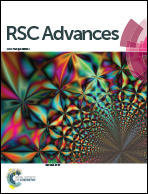Design, synthesis and biological evaluation of 1H-pyrrolo[2,3-b]pyridine derivatives as potent fibroblast growth factor receptor inhibitors†
Abstract
Abnormal activation of FGFR signaling pathway plays an essential role in various types of tumors. Therefore, targeting FGFRs represents an attractive strategy for cancer therapy. Herein, we report a series of 1H-pyrrolo[2,3-b]pyridine derivatives with potent activities against FGFR1, 2, and 3. Among them, compound 4h exhibited potent FGFR inhibitory activity (FGFR1–4 IC50 values of 7, 9, 25 and 712 nM, respectively). In vitro, 4h inhibited breast cancer 4T1 cell proliferation and induced its apoptosis. In addition, 4h also significantly inhibited the migration and invasion of 4T1 cells. Furthermore, 4h with low molecular weight would be an appealing lead compound which was beneficial to the subsequent optimization. In general, this research has been developing a class of 1H-pyrrolo[2,3-b]pyridine derivatives targeting FGFR with development prospects.
![Graphical abstract: Design, synthesis and biological evaluation of 1H-pyrrolo[2,3-b]pyridine derivatives as potent fibroblast growth factor receptor inhibitors](/en/Image/Get?imageInfo.ImageType=GA&imageInfo.ImageIdentifier.ManuscriptID=D1RA02660G&imageInfo.ImageIdentifier.Year=2021)


 Please wait while we load your content...
Please wait while we load your content...